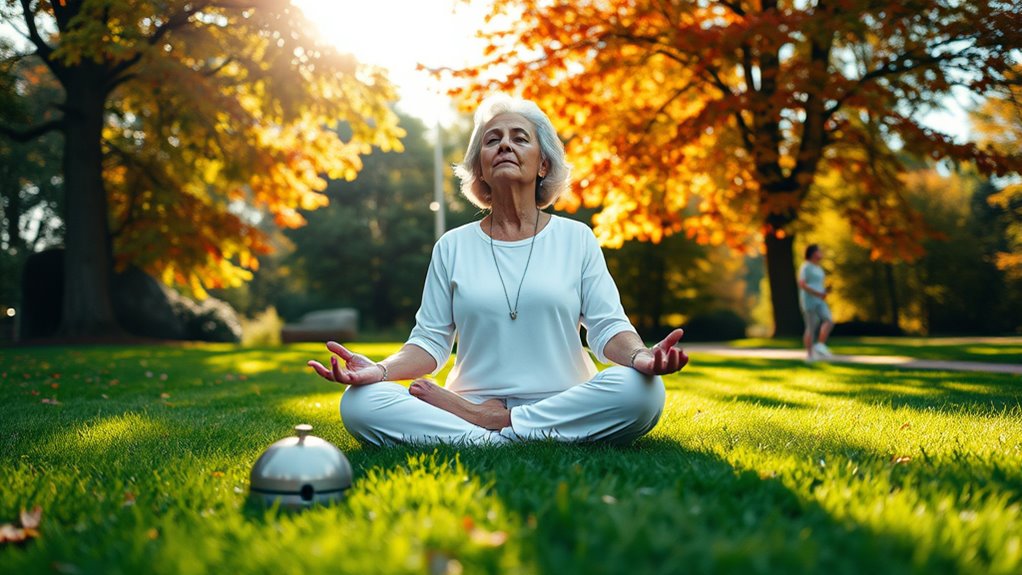By combining regular exercise with mindfulness practices, you can boost your mental resilience and support healthy aging. Exercise strengthens your physical health, improves blood flow, and enhances brain function, while mindfulness reduces stress, improves emotional regulation, and promotes neural plasticity. Together, these practices create a powerful synergy that promotes mental clarity, emotional balance, and longevity. Keep exploring how integrating simple habits can help you achieve long-term health and vigor.
Key Takeaways
- Combining exercise and mindfulness enhances brain connectivity, emotional regulation, and cognitive resilience, supporting long-term mental wellness and longevity.
- Short daily routines of mindful movement and light physical activity boost neuroplasticity and reduce age-related cognitive decline.
- Regular physical activity improves cardiovascular and respiratory health, which are vital for sustaining mental vitality over time.
- Mindfulness practices activate the parasympathetic nervous system, lowering stress hormones and strengthening immunity for healthier aging.
- Gradual habit formation and consistent practice foster resilience, emotional balance, and lasting mental wellness across the lifespan.
The Science Behind Exercise and Mindfulness in Aging
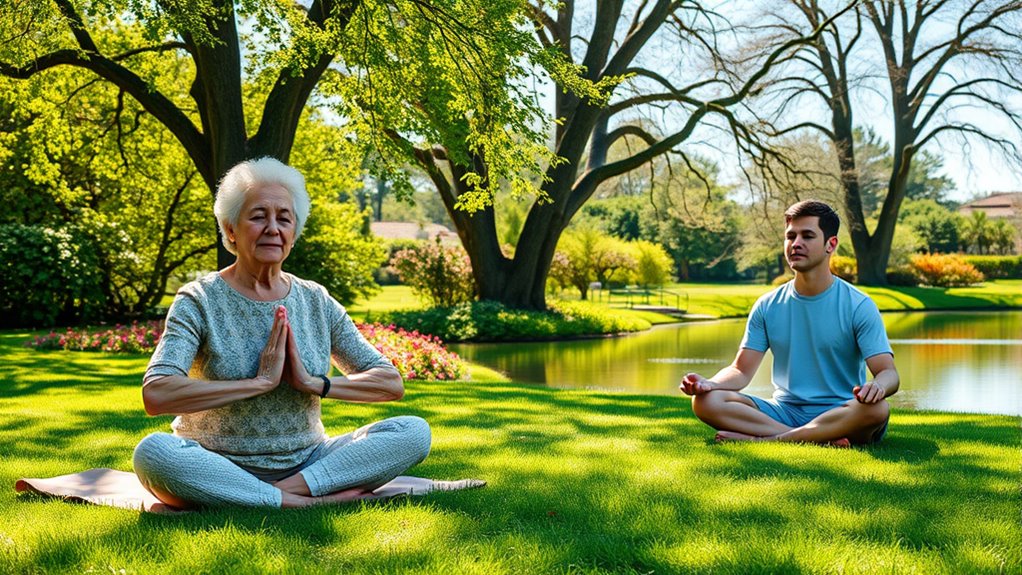
Understanding how exercise and mindfulness influence aging requires examining their distinct biological and neural mechanisms. When you engage in physical activity, it improves your physical fitness by lowering your resting heart rate and increasing respiratory capacity. These changes strengthen your cardiovascular system and boost resilience. Mindfulness, particularly practices like integrative body-mind training, activates your parasympathetic nervous system, leading to better heart rate variability and stress regulation. It also enhances immune function, increasing protective antibodies while reducing cortisol, the stress hormone. Brain imaging studies show mindfulness strengthens connectivity between regions involved in emotional regulation and cognitive control, promoting neural plasticity. Additionally, these practices contribute to self-regulation, helping individuals manage emotional responses more effectively. Together, these mechanisms help slow cellular decline, support mental health, and maintain adaptive stress responses, contributing to healthier aging.
How Physical Activity Boosts Physical Fitness and Resilience
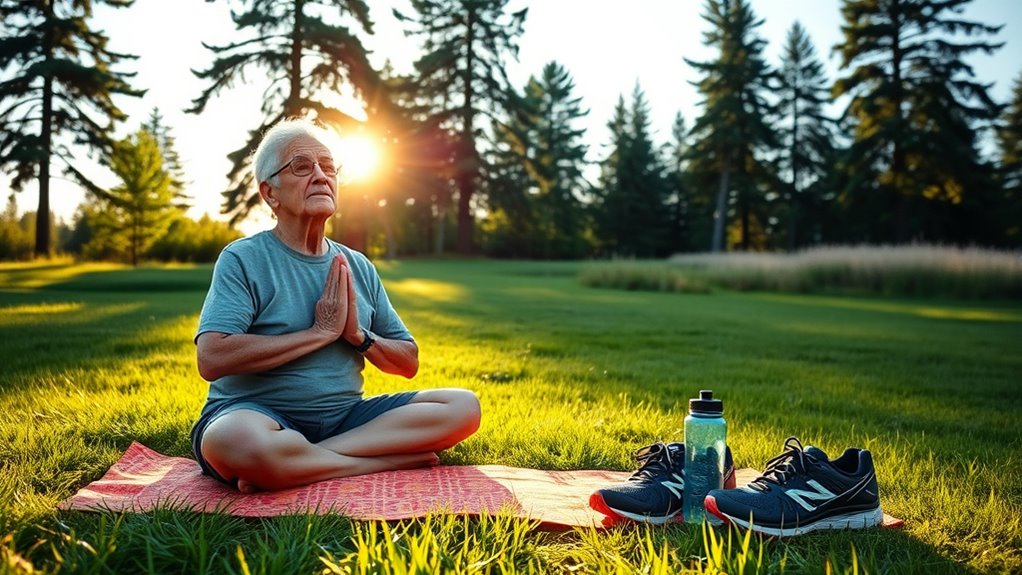
Engaging in physical activity directly improves your cardiovascular health by lowering resting heart rate and increasing lung capacity. It also helps build muscular endurance, making daily tasks easier and more sustainable. Together, these benefits strengthen your overall resilience, helping you bounce back from stress and physical challenges more effectively. Incorporating yarn yardage considerations when planning active hobbies can also contribute to mental wellness by fostering mindfulness and patience.
Enhances Cardiovascular Health
Physical activity plays a crucial role in boosting cardiovascular health by strengthening the heart muscle, improving blood circulation, and reducing risk factors like high blood pressure and cholesterol. Regular movement helps your heart pump more efficiently, lowering your risk of heart disease. It also enhances your blood vessels’ flexibility, supporting better oxygen and nutrient delivery. To see these benefits, consider activities like brisk walking, cycling, or swimming. Here’s a quick overview:
| Benefit | How It Works | Examples |
|---|---|---|
| Heart Strengthening | Builds muscle, improves pumping efficiency | Running, aerobics |
| Blood Circulation | Opens blood vessels, reduces blockages | Cycling, swimming |
| Risk Reduction | Lowers blood pressure and cholesterol | Brisk walking, dancing |
Consistent exercise improves resilience and keeps your cardiovascular system healthy longer. Additionally, maintaining an active lifestyle can positively influence mental well-being, supporting overall health and longevity.
Builds Muscular Endurance
Building muscular endurance is a key way to enhance your overall physical resilience and support long-term health. When you focus on increasing this endurance, you’re better prepared to handle daily activities and reduce injury risk. Regular strength training, like resistance exercises, challenges your muscles to sustain activity over time. This not only improves muscle stamina but also boosts metabolic health and bone strength. Incorporating testing tools into your routine can help monitor progress and ensure effective training.
- Incorporate exercises that target multiple muscle groups for balanced growth
- Use moderate weights with higher repetitions to build endurance
- Consistency is crucial; aim for 2-3 sessions weekly
- Combine strength training with mindful movement to enhance mental resilience
The Role of Mindfulness Meditation in Enhancing Mental Wellbeing
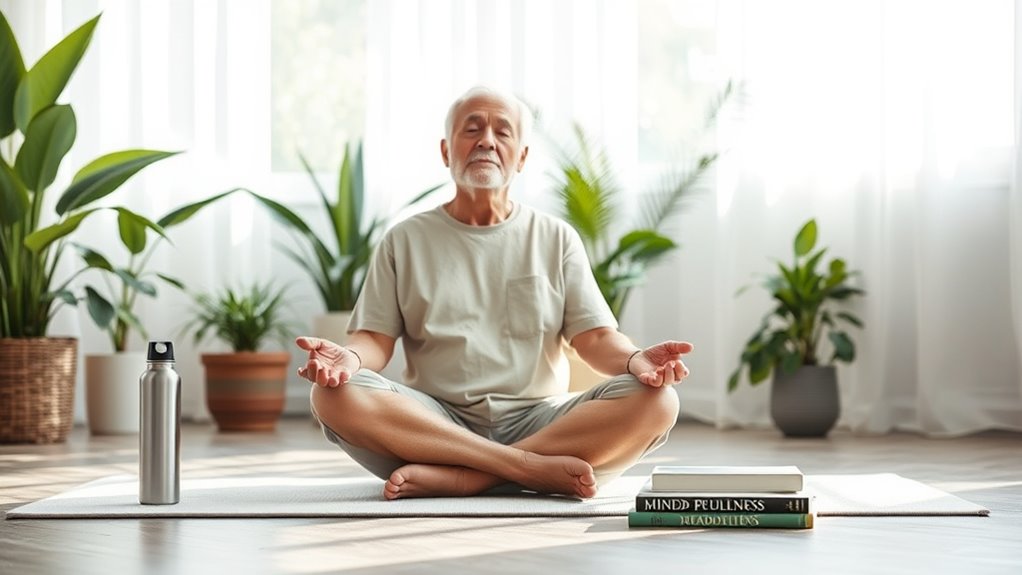
Mindfulness meditation plays a pivotal role in enhancing mental wellbeing by fostering greater emotional regulation, attention control, and stress resilience. When you practice mindfulness, you learn to observe your thoughts and feelings without judgment, helping you respond more calmly to stressors. This awareness strengthens your ability to manage anxiety, worry, and emotional upheaval. Regular mindfulness practice also improves focus and concentration, making daily tasks feel more manageable. Over time, it builds psychological resilience, allowing you to navigate life’s challenges with greater ease. Additionally, mindfulness promotes a sense of calm and balance, reducing the impact of stress on your mental health. Incorporating mental wellness techniques into your routine can further amplify these benefits and support a more positive outlook, emotional stability, and overall mental clarity.
Synergistic Effects: Combining Mindfulness and Exercise for Better Health
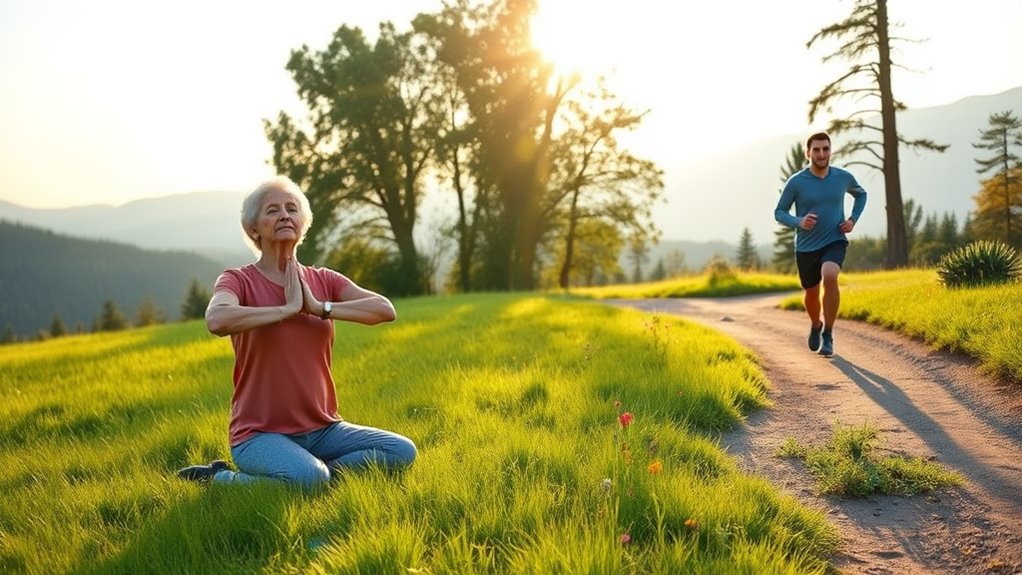
Combining mindfulness practices with regular exercise creates a powerful synergy that amplifies overall health benefits. This combo enhances mood, reduces stress, and improves physical resilience more effectively than doing either alone. You’ll find that mindfulness helps you stay present during workouts, boosting motivation and persistence. It also fosters a deeper connection between mind and body, making exercise more enjoyable and mindful. Additionally, incorporating mindfulness can improve mental clarity and help you better recognize your body’s signals during physical activity. Mind-body connection supports emotional regulation, helping you handle discomfort and setbacks during workouts. Both practices lower worry, anxiety, and stress, promoting mental clarity and calmness. Together, they strengthen resilience, making it easier to maintain healthy habits over time.
Short Daily Practices for Lasting Mental and Physical Benefits

Even just 10 minutes a day can substantially boost your mental and physical health by establishing a simple, consistent routine. You can start with quick mindfulness exercises, like focused breathing or body scans, to reduce stress and enhance emotional resilience. Pair these with light physical activities such as stretching, walking, or gentle yoga to improve circulation and mobility. These short practices help build habits that support long-term wellbeing, making it easier to stay motivated and committed. Incorporating mindfulness during exercise can deepen your awareness and enjoyment while reducing perceived effort. Consistency is key; over time, these brief daily efforts reinforce positive behaviors and foster greater mental clarity, physical vitality, and resilience, setting a foundation for lasting health benefits. Additionally, integrating practices like meditation can improve sleep quality, further amplifying these benefits sleep and mental health.
Impact on Brain Structure and Cognitive Function in Older Adults
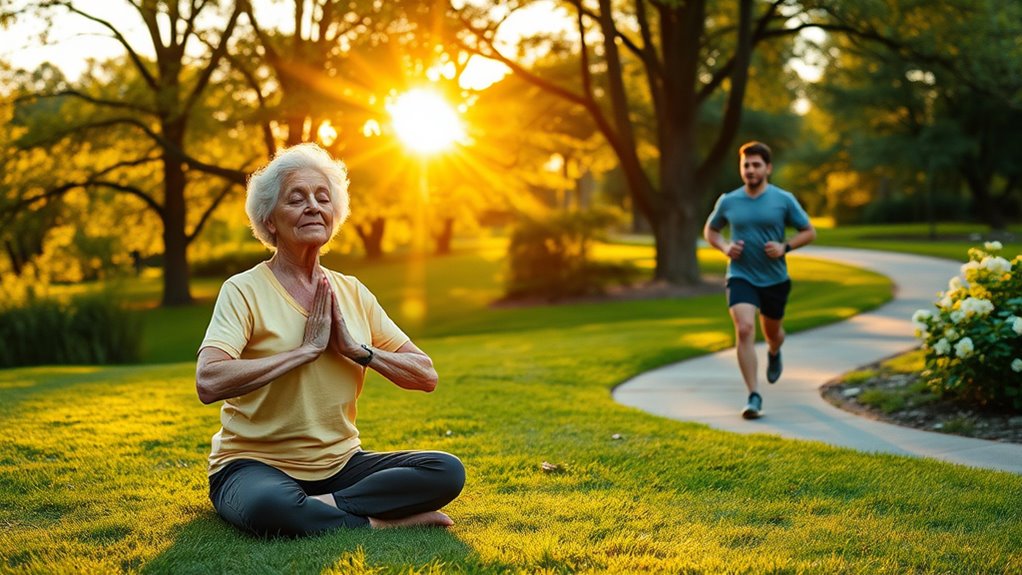
Research indicates that engaging in mindfulness and exercise can influence brain structure in older adults, though their effects on cognitive function are complex. These activities promote neuroplasticity, but outcomes vary across individuals and cognitive domains. You may experience increased gray matter volume in regions like the hippocampus and prefrontal cortex, which are pivotal for memory and decision-making. AI safety measures are crucial to ensure these beneficial practices are implemented responsibly in health interventions.
- Mindfulness strengthens connectivity between brain areas involved in attention and emotional regulation.
- Exercise enhances neural pathways linked to executive function and processing speed.
- Both practices can slow age-related brain atrophy, supporting cognitive resilience.
- However, improvements in specific cognitive skills may require targeted or more intensive interventions for meaningful effects.
Mind-Body Exercises and Their Role in Age-Related Health Improvements
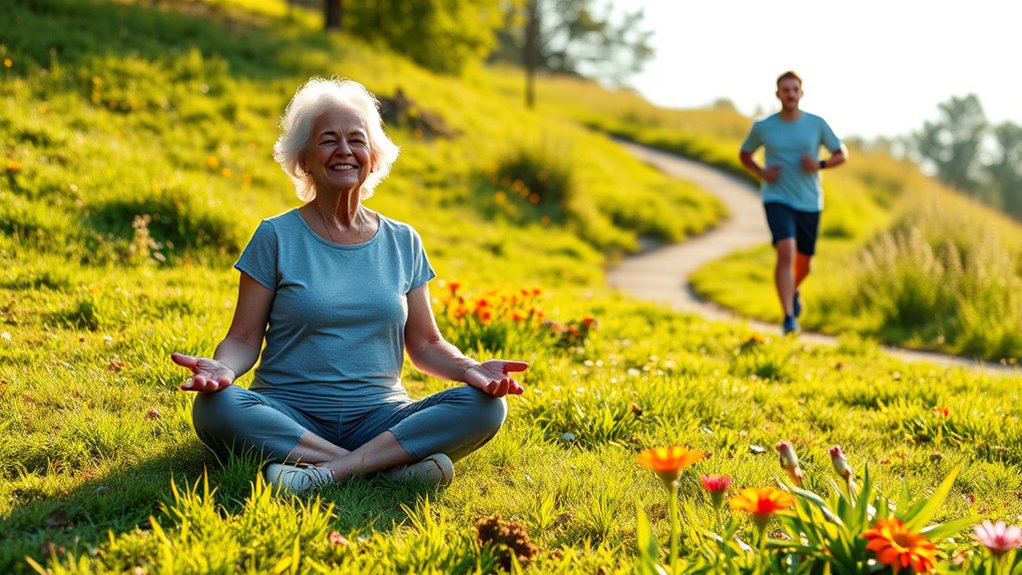
Mind-body exercises like Tai Chi, Qigong, and dance-based activities play a significant role in improving health outcomes as you age. These practices integrate gentle movement, breath control, and mental focus, which enhance physical function and emotional well-being. They help improve sleep quality, reduce pain, and boost immune function, supporting overall energy. Such exercises also promote better balance and flexibility, decreasing fall risk. Beyond physical benefits, they foster mindfulness, emotional regulation, and stress reduction, which contribute to mental resilience. Engaging regularly in mind-body activities encourages a sense of community and purpose, essential for healthy aging. Their holistic approach addresses both body and mind, making them effective tools for age-related health improvements and long-term wellness. Incorporating Boho Decor elements into your space can create a calming environment that enhances the mental benefits of these practices.
Strategies for Incorporating Wellness Practices Into Daily Life
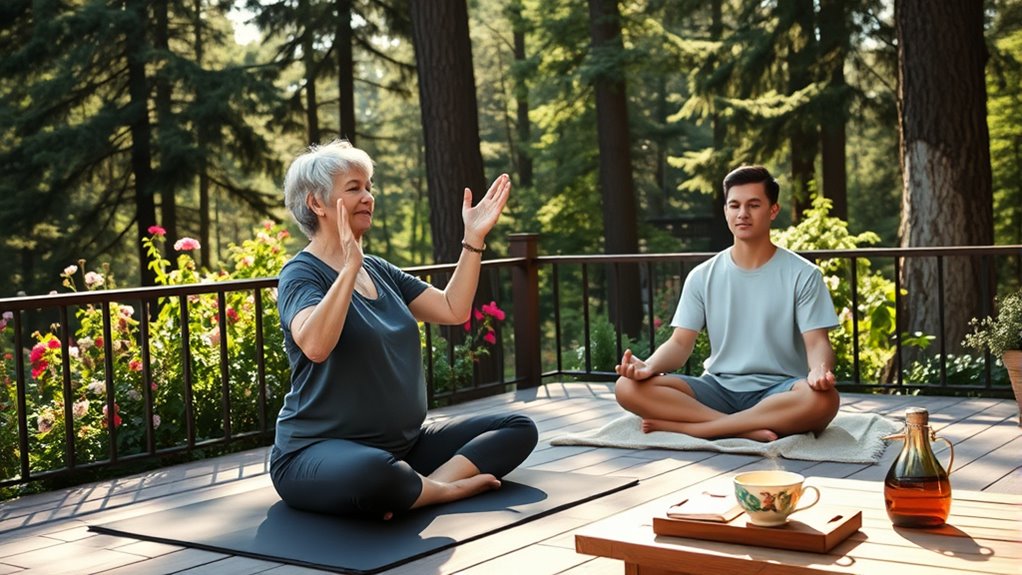
Incorporating wellness practices into your daily routine can considerably enhance your overall health and resilience. To make this sustainable, start small and build consistency. Set aside a specific time each day, whether morning or evening, to practice mindfulness or exercise. Use simple tools like mindfulness apps or short workouts to stay motivated. Focus on integrating activities naturally into your day, such as stretching during breaks or mindful breathing before bed. Remember, high-intensity workouts are not necessary for benefits; gradual, consistent effort is more effective. Keep it realistic and flexible to prevent burnout. Over time, these small changes will strengthen your mental and physical health, creating a healthier, more resilient lifestyle.
Frequently Asked Questions
How Do Exercise and Mindfulness Specifically Influence Cellular Aging Markers?
You can influence cellular aging markers by engaging in exercise and mindfulness. Exercise increases telomerase activity and lengthens telomeres, which protect cells from aging. Mindfulness reduces cortisol levels, lowering stress that damages cells. Combining both can enhance immune function and potentially slow cellular aging. Regular practice of these activities supports healthier cellular processes, helping you maintain energy and longevity as you age.
Can Mindfulness and Exercise Prevent or Delay Age-Related Cognitive Decline?
You might think mindfulness and exercise are magic bullets for keeping your brain young, but they aren’t foolproof. While they boost mood, reduce stress, and improve neural connections, studies show they don’t reliably prevent or delay cognitive decline in older adults. Still, staying active and mindful can support overall brain health; just don’t expect them to turn back the clock completely. It’s more about gradual preservation than miracle cures.
What Are the Best Practices for Integrating These Methods Into Busy Daily Routines?
To fit exercise and mindfulness into your busy routine, start small with just 10 minutes daily, like quick stretches or deep breathing. Use apps or guided videos to stay focused and motivated. Incorporate mindfulness during everyday activities, such as mindful eating or walking. Schedule regular breaks for brief exercises or meditation. Consistency matters, so make these practices a non-negotiable part of your day for lasting benefits.
Are There Any Risks or Contraindications for Older Adults Practicing Mindfulness or Physical Activity?
Are you aware of potential risks? While mindfulness and exercise are generally safe, older adults should consult their healthcare providers first. Risks include falls during physical activity, especially if balance is an issue, or overstimulation from intense meditation. Starting slowly, choosing appropriate exercises, and listening to your body can minimize dangers. Do you think adapting routines to your comfort level makes a difference? It definitely does.
How Do Personalized Approaches Enhance the Effectiveness of Wellness Interventions?
You enhance wellness intervention effectiveness by tailoring approaches to your unique needs, preferences, and health status. Personalized plans increase motivation, adherence, and engagement, making practices more relevant and enjoyable. By adjusting intensity, duration, and techniques, you reduce the risk of discomfort or injury. This customization helps you stay consistent, boosts confidence, and optimizes mental and physical benefits, ultimately supporting sustained healthy habits and long-term well-being.
Conclusion
By combining regular exercise and mindfulness, you can substantially boost your longevity and mental wellness. Studies show that just 20 minutes of daily activity can reduce cognitive decline by up to 30%. Incorporating these practices into your routine isn’t just about adding years to your life but enriching those years with better mental clarity and resilience. Start small, stay consistent, and watch your overall health and happiness improve seamlessly over time.
